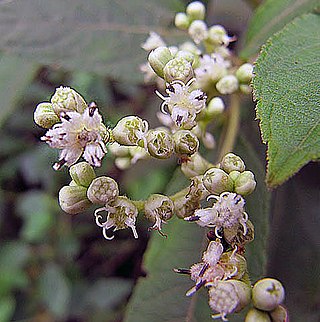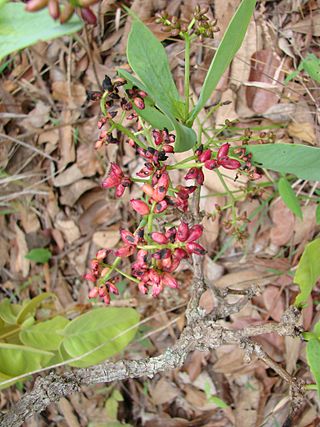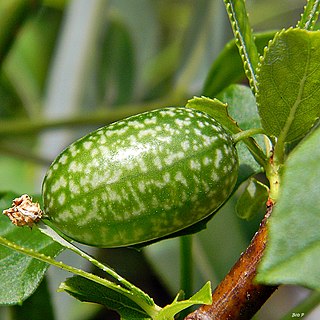
The Cucurbitaceae, also called cucurbits or the gourd family, are a plant family consisting of about 965 species in 101 genera. Those most important to humans are the following:

Sobralia is a genus of orchids native to Mexico, Central and South America. The plants are more commonly terrestrial, but are also found growing epiphytically, in wet forests from sea level to about 8,800 ft. The genus was named for Dr. Francisco Sobral, a Spanish botanist. The genus is abbreviated Sob in trade journals.

Chayote or Sicyos edulis, also known as christophine, mirliton and choko, is an edible plant belonging to the gourd family, Cucurbitaceae. This fruit was first cultivated in Mesoamerica between southern Mexico and Honduras, with the most genetic diversity available in both Mexico and Guatemala. It is one of several foods introduced to the Old World during the Columbian Exchange. At that time, the plant spread to other parts of the Americas, ultimately causing it to be integrated into the cuisine of many Latin American nations.

Columnea is a genus of around 200 species of epiphytic herbs and shrubs in the family Gesneriaceae, native to the tropics of the Americas and the Caribbean. The tubular or oddly shaped flowers are usually large and brightly colored – usually red, yellow, or orange – sometimes resembling a fish in shape. A common name is flying goldfish plants due to the unusual flower shape.

Sicyos is a flowering plant genus of the family Cucurbitaceae. Members of the genus may be known as "burr cucumbers", but the genus includes Sicyos edulis which is the christophine or chayote.

Clibadium is a genus of flowering plants in the family Asteraceae.
Plagiocheilus is a genus of flowering plant in the family Asteraceae. It is now classified in tribe Astereae, but used to be placed with the Anthemideae.

Neea is a genus of plants in family Nyctaginaceae from the Caribbean region, Central and South America. Members of the genus are commonly called Nia, Neea, or saltwood.

Acianthera is a genus of orchids native to the tropical parts of the Western Hemisphere, especially Brazil. It was first described in 1842 but was not widely recognized until recently. Most of the species were formerly placed under Pleurothallis subgenus Acianthera. This splitting is a result of recent DNA sequencing.

Ida, synonym Sudamerlycaste, is a genus of flowering plants in the family Orchidaceae. It consists of approximately 45 species and hybrids. The genus was split off from Lycaste in the early 2000s.
Epidendrum tridens is a terrestrial orchid closely allied to E. nocturnum, of which it has often been considered a variety or synonym. For example, Reichenbach 1861 lists Epidendrum tridens(Poepp. & Endl.) Cogn. (1898) as a synonym of Epidendrum nocturnum and Epidendrum nocturnum var. latifoliumLindl. (1837) as a distinguishable variety of Epidendrum nocturnum.

Cyclopogon is a genus of flowering plants from the orchid family, Orchidaceae. It is a fairly large genus distributed widely over much of South America, the Galápagos, Central America, Mexico and the West Indies, with 2 species (C. elatus + C. cranichoides) in southern Florida.

Elleanthus is a genus of flowering plants from the orchid family, Orchidaceae. They are commonly known as tiger orchid. All the species are native to the warmer parts of the Western Hemisphere.

Sarcoglottis is a genus of flowering plants from the orchid family, Orchidaceae. It is widespread across much of Latin America from Mexico to Argentina, with one species extending northward into Trinidad and the Windward Islands.

Zehneria is a genus of flowering plants – of vines in the cucumber and gourd family, Cucurbitaceae. It contains about 35 species ranging from Africa, through Southeast Asia to Australia and Oceania. The name honours botanical artist Joseph Zehner.

Cayaponia is among the largest genera in the gourd family, Cucurbitaceae, with 74 species. The plants are referred to as melonleaf. They are common from the southern United States to South America. Some species are also found in western Africa, Madagascar, and Fernando de Noronha, which is about 354 km (220 mi) off the coast of Brazil.

Melothria is a genus of flowering plants in the family Cucurbitaceae, native to the Americas from the United States to Argentina, and with some introductions in Africa and elsewhere. A number of Old World species formerly in Melothria were reassigned to Cucumis.
Microsechium is a genus of flowering plants belonging to the family Cucurbitaceae.















